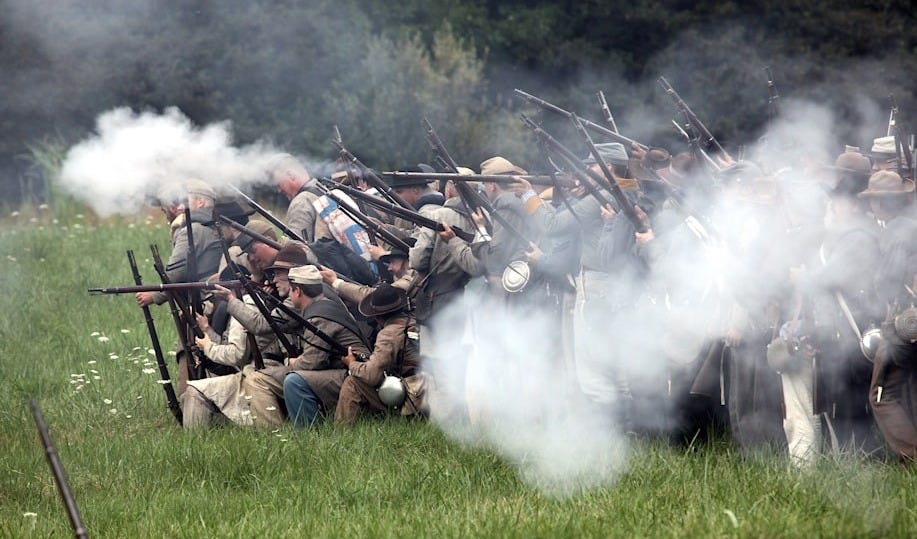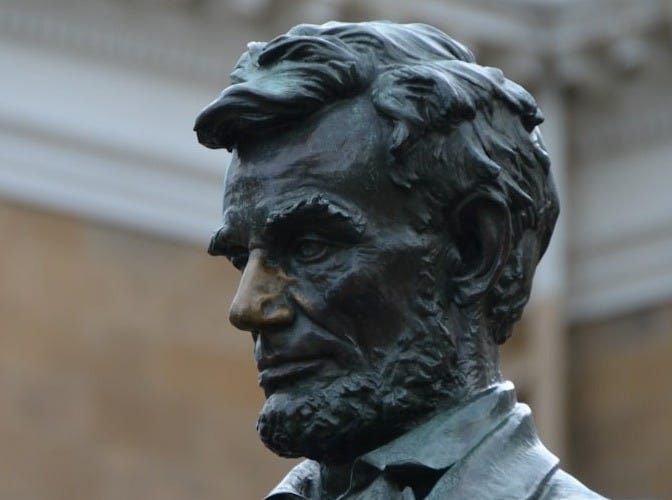We often see the American past as a chronology of encapsulated periods or eras. We divide one from the next even though there were always continuities – and although people were not aware they were living in a defined era whose years, i.e., 1848-65, would one day adorn the cover of a history book.
We have the founding era of 1765-89, the Stamp Act crisis to the first Congress under the new Constitution. And there’s 1929-45, the onset of the Great Depression to Allied victory in the Second World War. At least this is how the Oxford History of the United States organizes the past.
You might say the antebellum period ended on April 12, 1861, when Confederate forces bombarded Fort Sumter and Lincoln called for 75,000 troops to put down the rebellion three days later. But does it make sense to define the start of the Civil War era when the war began?
In James McPherson’s Pulitzer Prize-winning Battle Cry of Freedom, this era commences in 1848, not long after U.S. forces captured Mexico City in the Mexican-American War. Broad expanses of present-day Nevada, California, Utah, Arizona, and New Mexico were ceded to the United States, turbocharging the debate over the expansion of slavery, a primary cause of the war that broke out thirteen years later.
It must be easier to identify the end of the American Civil War, right? Maybe not. Confederate General Robert E. Lee surrendered to Union General Ulysses S. Grant at Appomattox Court House 160 years ago this week. But the fighting continued – small battles involving Confederate holdouts – into mid-May.
The secessionists failed to establish a state built on the cornerstone of slavery, but political conflict and terrorist violence targeting the newly freed Black Americans continued for many years after 1865. Was this a continuation of the war or something else?
One war, many endings
Did you know President Andrew Johnson proclaimed the Civil War over in August 1866? I didn’t until picking up historian Michael Vorenberg’s Lincoln’s Peace: The Struggle to End the American Civil War. Neither did Vorenberg – not until he began researching his book – although he’s been an expert on the Civil War and emancipation at Brown University since 1999.
Other possible end dates further cloud the picture. Vorenberg points to Juneteenth, when the U.S. Army arrived in Texas and announced that 250,000 enslaved Black people in the state were free. There’s also the ratification of the Thirteenth Amendment in December 1865. After all, the South (except the “border states”) seceded to protect the institution of slavery, and Lincoln and the Republicans prosecuted the war to destroy that peculiar institution. The abolition of human chattel slavery was an achievement of world historical importance.

There’s more at stake here than winning a ‘this-date-in-history’ trivia contest. “The choice of an end date also has consequences for how the war is remembered. Wittingly or unwittingly, the choice of an end date makes one complicit in assigning a meaning that matters most to the war,” writes Vorenberg (p. xxix).
How we remember the Civil War and the fight for Black civil and political rights that followed will always matter. Conflicting renderings of this story still animate our political and social disputes. After the founding, it is the most important period in U.S. history.
I often say wars do not end; they migrate to our minds. Whichever date we pick, it’s more important to understand the end of the American Civil War not as a one-day event – the significance of Lee’s surrender notwithstanding – but rather a complex process that played out for decades afterward. I apply this same kind of thinking to the Cold War’s end. Look at Eastern Europe today. The collapse of the Soviet Union in 1991 continues to ripple violently – “the wars of Soviet succession.” Violence is the norm when empires fall to pieces.
In Tuesday’s episode of History As It Happens, Vorenberg guides us over the Civil War’s metaphysical battlefields. From the moment Lee and Grant shook hands at Appomattox, some Southerners began subscribing to the notion that they weren’t truly defeated and could have kept fighting for months or years. They constructed a myth – the Lost Cause – without slavery as the cause for which they fought.
“One of the Confederate officers at Appomattox says to his [Union] counterpart something like, you may have won the day and we have surrendered, but you will never subdue us. You will never subdue us. That idea is so integral to the idea of the Lost Cause… That idea speaks to the metaphysical,” says Vorenberg.
And on the ground, real violence proliferated: “Some of these so-called skirmishes [after Appomattox] are better thought of as insurgencies. During Reconstruction… there is paramilitary action by white supremacists committing massacres of Black people and certain white unionists,” says Vorenberg.

So the former Confederates did fight on – not only for a short time on secluded battlefields but for years as terrorists in the Ku Klux Klan and eventually as elected leaders in a “redeemed” South. They had destroyed Reconstruction in the 1870s. Starting in Mississippi in 1890, every state of the former Confederacy legally disenfranchised Black men. Georgia was the last to do so in 1908. Jim Crow survived another half century.
President Lyndon Johnson invoked this history when addressing Congress on March 15, 1965, in support of the Voting Rights Act:
“At times history and fate meet at a single time in a single place to shape a turning point in man’s unending search for freedom. So it was at Lexington and Concord. So it was a century ago at Appomattox. So it was last week in Selma, Alabama…
But a century has passed, more than a hundred years, since the Negro was freed. And he is not fully free tonight. It was more than a hundred years ago that Abraham Lincoln, a great president of another party, signed the Emancipation Proclamation, but emancipation is a proclamation and not a fact. A century has passed, more than a hundred years, since equality was promised. And yet the Negro is not equal. A century has passed since the day of promise. And the promise is unkept.
The time of justice has now come. I tell you that I believe sincerely that no force can hold it back. It is right in the eyes of man and God that it should come. And when it does, I think that day will brighten the lives of every American.”
Also discussed in my wide-ranging conversation with Michael Vorenberg: Appomattox and American exceptionalism; whether Gettysburg made Confederate defeat inevitable; why Lee kept gambling after Lincoln’s 1864 reelection; why Jefferson Davis said his armies were better off after Richmond fell to the Union; comparisons to Vietnam and Iraq; Confederates in Mexico; awfulness of Andrew Johnson; whether 1877 marked the “formal end” of Reconstruction; Jim Oakes, Eric Foner, and W. E. B. Du Bois; and why the Confederates won the “history war.”
Listen/subscribe to the podcast here. Remember, History As It Happens is available wherever you find your favorite podcasts. You don’t have to wait for this newsletter every Friday.
From Atatürk to Erdoğan
A century ago modern Turkey was established from the remnants of the Ottoman Empire. Its first leader was Mustafa Kemal, better known as Kemal Atatürk – Father of the Turks. Atatürk galvanized his people and created a republic based on the principles of secularism, populism, and nationalism. He was one of the most extraordinary leaders of the twentieth century, and although not a liberal democrat, Atatürk was “a committed Westernizer” who “established respect for the law” while laying “the groundwork for popular participation in government.”
“The authoritarian features of Atatürk’s republic aroused suspicions in the West, but the democratic institutions he established have endured,” writes William Cleveland in A History of the Modern Middle East (p. 181).
If Cleveland, who died in 2006, could revise his book, he might change the wording of the last sentence, because Turkey’s democratic institutions are being demolished by its strongman leader Recep Erdoğan.
We are living in increasingly authoritarian (or autocratic) times. Democratic institutions and the liberal values of free expression, political pluralism, and cultural tolerance are under assault. Erdoğan’s attack on Turkey’s secular democracy has been underway for close to two decades, as the Middle East Institute’s Gönül Tol explained in Friday’s episode of History As It Happens.
“Erdoğan has recently taken a huge step that would pave the way to turn the country’s competitive authoritarian regime into a Putin-style autocracy,” says Tol, who says Erdoğan has incrementally seized power over the past two decades.
The “huge step” was the arrest of Istanbul’s popular mayor Ekrem Imamoglu, the only person to have beaten Erdoğan’s ruling party in three local elections. He faces bogus charges of corruption and terrorism. “Many see the arrest as part of a broader campaign to undermine the mayor and eliminate a key challenger to Erdogan before the next presidential elections,” reports the Associated Press.

The Imamoglu case is a sign that Turkey’s president is willing to do almost anything to stay in power, torching what’s left of the country’s pluralistic politics.
“Erdoğan came to power in 2002 when he captured 37 percent of the vote, which was huge. And thanks to Turkey’s unique electoral law, the 37 percent translated into a huge mandate in the Turkish parliament. His initial steps were very much in line with a strong reform agenda. It secured him the backing of unlikely constituencies… liberals, conservatives, Kurds, Islamists, secularists, and his number one goal was to curb the military’s power in politics,” says Tol.
Historically, the Turkish military played a “guardian role” defending Kemalist secularism, intervening directly to unseat ruling governments in 1960, 1971, and 1980 before returning power to the civilians. The third coup d'état led to the creation of Turkey’s current constitution, which Erdoğan is tearing to pieces – a process that accelerated after a failed military coup in 2016.
In an essay (no paywall) for Foreign Affairs, the official publication of the Council on Foreign Relations, Tol says Erdoğan exploited the state of emergency to crush the remaining opposition.
“After a failed coup attempt by military officers in 2016, which Erdoğan and his party linked to a movement whose members populated other branches of government and public institutions, Erdoğan brought the judiciary under his authority by purging thousands of judges and replacing them with loyalists who rubber-stamp his crackdowns. The media have been muzzled; more than 90 percent of Turkish media outlets are owned by pro-government businesses, and independent journalists are routinely jailed,” she writes.
A decade later, Turkey’s strongman is now resorting to choosing his electoral opponents by tossing the strongest potential challengers into prison.
“Even during the reform years, there were troubling signs of what was to come. Erdoğan used state institutions to stop the rise of his political opponents… to keep his ideologically wide coalition together, and he didn’t want to provoke the secular establishment,” says Tol.
Because of the Islamist roots of his Justice and Development Party (AKP), Erdoğan felt it necessary to immediately “calm fears of a shift away from secularism.”
“He wanted the Western world on his side, so if you look at his early years you might praise his reform agenda,” says Tol. Yet as early as 2004, we can identify moves to consolidate power at the top.
Turkish financial authorities in the Savings and Deposit Insurance Fund seized more than 200 companies owned by a prominent family. They accused the family patriarch Cem Uzan of financial fraud. Uzan had founded a rival political party, the Young Party, in 2002.
“The Uzan group’s holdings, including Turkey’s first private TV channel and several newspapers, were all seized and sold to pay back his debts,” says Tol. “The Doğan Media Group, which at the time had good relations with the Erdoğan government, purchased [Uzan’s TV station] and the newspaper was sold to a pro-AKP business group. It was one of the earliest dents in Erdoğan’s carefully crafted image of a reformer.”
From democracy to something else
Listening to Gönül Tol in today’s podcast might make you reflect on what’s happening in the United States, as the Trump administration tramples civil liberties and weaponizes the federal government against the president’s perceived enemies, such as those who opposed Trump’s attempt to steal the 2020 election. You might consider a question weighing on my mind nowadays: What does it take to turn a rule-of-law republic into an authoritarian government?
It doesn’t happen with a single, spectacular blow. There will be no “march on Rome.” Rather, we are witnessing death by a thousand cuts, overwhelming the political opposition, the courts, news media, and ordinary citizens’ ability to process an avalanche of breaking news headlines. It also reminds me of something Ithaca College political science professor Robert Kurlander said to my class way back in 1994: the Constitution is just words on a piece of paper. The document does not defend itself, and if enough people who are in power are willing to ignore it, it becomes something of a dead letter.
No, the U.S. under Trump is not Turkey (I will not be arrested for criticizing my president), and Turkey is not quite Putin’s Russia yet, either. I will return to the subject of the erosion of democracy and “transition” to authoritarianism and dictatorship in a podcast to be published on May 6. It will feature an interview with the historian and documentary filmmaker Laurence Rees about his superb yet unsettling new book The Nazi Mind.
Coming up next
In next Tuesday’s episode of History As It Happens, the historian Omer Bartov will tackle a pressing issue: what is antisemitism? We will also talk about his related essay in The New York Review about Israel’s ongoing genocide of Palestinians in Gaza.
This episode will follow the approach I took in previous podcasts. What is Zionism? with Ian Lustick, and What is Intifada? with Khaled Elgindy.
In next Friday’s episode, historian Nelson Lichtenstein will discuss the origins of the unfolding trade war. Trump’s sweeping tariffs – as of this writing, he has delayed some reciprocal duties for 90 days – are meant to reverse global economic arrangements that were decades in the making. Deindustrialization goes back at least half a century, and in the 1980s the Reagan administration tried to pry open foreign markets that were supposedly being unfair to U.S. exporters.
See this article from 1985 in the Los Angeles Times: “In that spirit, President Reagan ended the accord whereby Japanese auto exports to this country were limited to 1.85 million annually. In return, the United States indicated it wanted Japan to hold down auto exports administratively, while opening up markets in communications equipment, electronics, forest products and pharmaceuticals.”





Just finished the podcast. Good stuff. I’m currently reading “April 1865” by Jay Winik for the 160th anniversary.